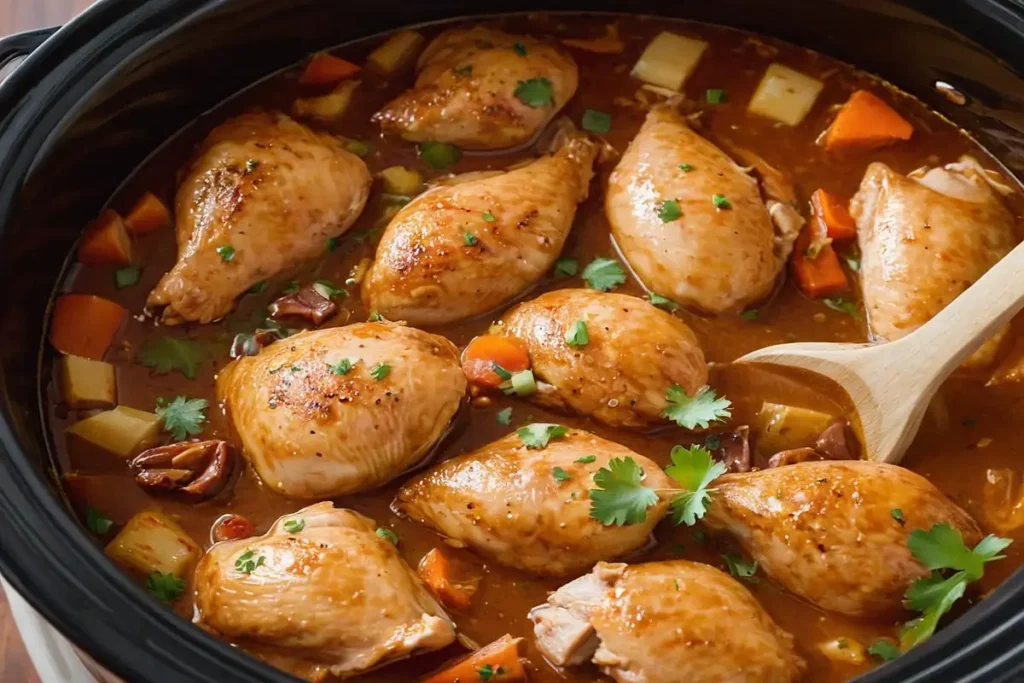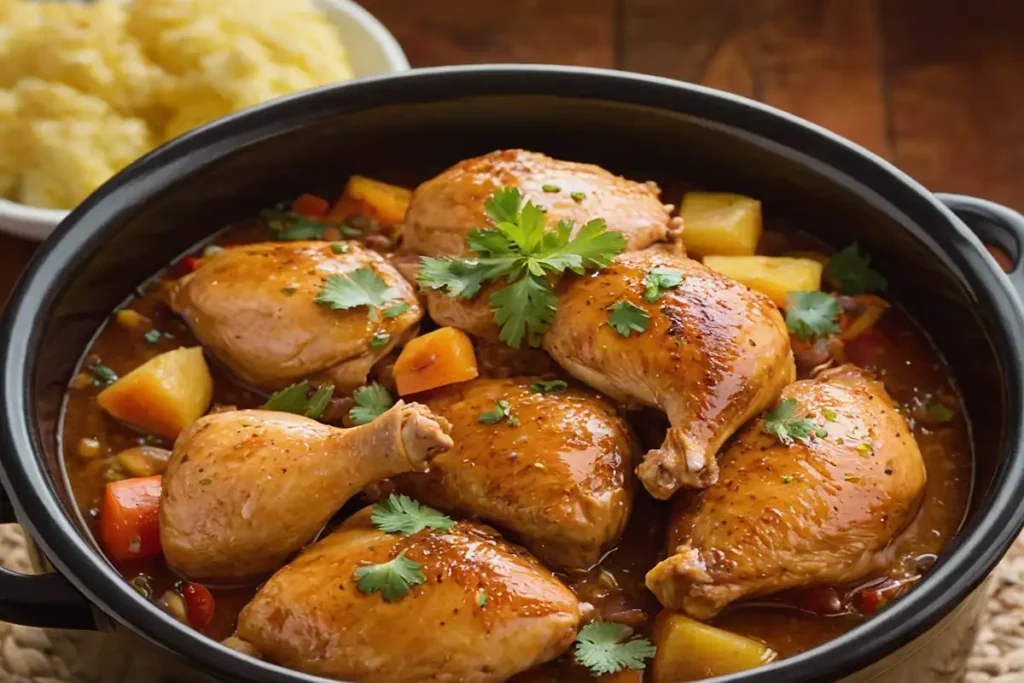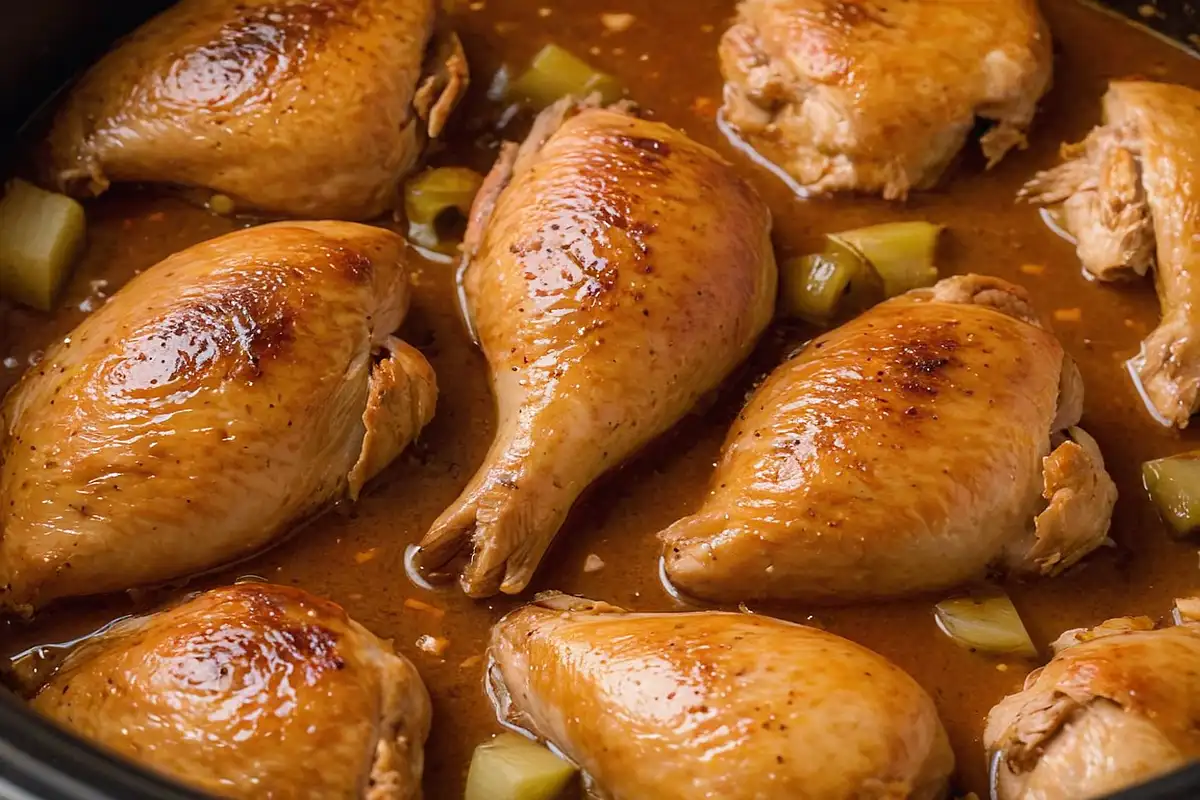Introduction

What is Hawaiian chicken sauce made of? This question might pop up when you’re enjoying the sweet, tangy flavors of Hawaiian chicken. The sauce is crucial to the dish, turning simple ingredients into a delicious meal that captures the spirit of Hawaiian cuisine. Whether you’re grilling, baking, or stir-frying, understanding what goes into Hawaiian chicken sauce can elevate your cooking. Let’s dive into the ingredients, preparation, and cultural significance of this flavorful sauce.
The Essentials of Hawaiian Chicken Sauce
To appreciate the sauce, it’s helpful to grasp its basics. Hawaiian chicken sauce blends sweet, tangy, and savory elements, often with a touch of spice. This unique combination makes the sauce versatile and loved by many. The flavors, such as pineapple and soy sauce, are deeply rooted in Hawaiian culinary traditions, reflecting the island’s diverse influences.
Main Ingredients in Hawaiian Chicken Sauce
When exploring what goes into Hawaiian chicken sauce, it’s essential to break down the key components that give the sauce its distinctive taste. Each ingredient plays a vital role in balancing the flavors.
Pineapple Juice: The Sweet Base
Pineapple juice adds natural sweetness and a slight tang, perfectly balancing the savory elements of the sauce. Whether using fresh or canned pineapple juice, it brings a vibrant, refreshing flavor that’s signature to Hawaiian dishes. Additionally, pineapple juice helps tenderize the chicken, making it juicier and more flavorful .
Soy Sauce: The Savory Depth
Soy sauce brings rich, umami depth, balancing the sweetness of pineapple juice and brown sugar. Low-sodium soy sauce is often preferred to keep the sauce from becoming too salty. Soy sauce ties together the various flavors, creating a cohesive taste.
Brown Sugar: Sweetness with Depth
Brown sugar is essential for enhancing the sauce’s sweetness and adding depth. The molasses in brown sugar provides a rich, caramel-like flavor that complements the tangy pineapple juice. While honey or white sugar can substitute, brown sugar offers a unique taste that’s key to the sauce.
Adding Spice with Sweet Chili Sauce
Asian sweet chili sauce isn’t always included, but it adds complexity and a hint of heat to the sauce. This ingredient introduces subtle spice, contrasting nicely with the sweetness of pineapple and brown sugar. It brings an extra layer of flavor for those who like a bit of heat.
Aromatic Garlic and Ginger
Garlic and ginger are crucial for adding depth and fragrance to the sauce. Fresh garlic and ginger are usually preferred for their potent flavor, though powdered versions can work if necessary. These aromatics help balance the sauce, ensuring each bite is flavorful and aromatic.
Ketchup: A Surprising Addition
Ketchup may seem unusual, but it’s common in many versions of Hawaiian chicken sauce. It adds tang and a rich red color, making the sauce visually appealing. Ketchup also helps thicken the sauce, giving it a nice consistency that clings to the chicken.
Exploring Additional Ingredients in Hawaiian Chicken Sauce
While the core ingredients are essential, other components can be added to customize the sauce to your taste.
Worcestershire Sauce for Extra Flavor
Worcestershire sauce is sometimes added for a deeper, tangy flavor. This fermented sauce complements the sweetness of pineapple and brown sugar, adding complexity to the sauce.
Thickening with Cornstarch
Cornstarch is often used to thicken Hawaiian chicken sauce. When mixed with water and added to the sauce, it achieves the desired consistency, ensuring the sauce coats the chicken well.
Adding a Tangy Note with Rice Vinegar
Rice vinegar introduces mild acidity, balancing the sweetness of pineapple juice and brown sugar. This ingredient brightens the flavor, making the sauce more vibrant.
Richness from Butter
Butter is sometimes added to give the sauce a rich, smooth texture. It melts into the sauce, adding subtle richness that enhances the overall flavor.
Preparing Hawaiian Chicken Sauce
Knowing the ingredients is just the first step. Understanding how to prepare the sauce is crucial for achieving the perfect flavor and consistency.
Mixing the Ingredients
Start by whisking all the ingredients together in a bowl. This ensures even distribution of flavors and dissolves the sugar completely. Whisking is a simple but crucial step in creating a smooth, uniform sauce.
Cooking for Flavor
After mixing, cook the sauce over medium heat. This step allows the flavors to meld and the sauce to thicken. Cooking helps develop the flavors, whether you’re making a marinade, glaze, or dipping sauce.
Achieving the Right Consistency
If the sauce is too thick, thin it with water or pineapple juice. If it’s too thin, thicken it with a cornstarch slurry. Adjusting consistency is key to perfecting the sauce, ensuring it’s just right for your dish.
Customizing Hawaiian Chicken Sauce
One of the best parts of knowing how to make Hawaiian chicken sauce is customizing it to suit your tastes.
Balancing Sweetness and Tanginess
For a sweeter sauce, increase the brown sugar or add honey. For more tang, try adding extra pineapple juice or a splash of rice vinegar. Customizing the balance allows you to create a sauce that perfectly complements your dish.
Spicing It Up
If you like a bit of heat, add chili flakes or extra sweet chili sauce. This creates a spicy-sweet flavor that’s both exciting and delicious.
Gluten-Free Options
For a gluten-free version, use tamari or coconut aminos instead of soy sauce. This substitution keeps the sauce flavorful while being safe for those with gluten sensitivities.
Pairing Hawaiian Chicken Sauce with Different Dishes

Now that you know what goes into Hawaiian chicken sauce, let’s explore how to use it in various dishes.
Classic Chicken Pairing
The most popular use of Hawaiian chicken sauce is with chicken. Whether grilled, baked, or stir-fried, the sauce enhances the chicken’s flavor, making it juicy and flavorful.
Using the Sauce in Multiple Ways
The sauce can serve as both a marinade and a glaze. As a marinade, it tenderizes and flavors the chicken. As a glaze, it creates a sticky, flavorful coating that’s perfect for grilling or baking.
Versatile Pairings Beyond Chicken
Hawaiian chicken sauce isn’t just for chicken. It’s also excellent with pork, tofu, and seafood. The sweet and tangy flavors complement these proteins, making them great alternatives.
Understanding the Cultural Roots
The sauce isn’t just about flavor; it also carries cultural significance, reflecting the diverse culinary influences in Hawaii.
Blending Hawaiian and Asian Flavors
Ingredients like pineapple, soy sauce, and ginger highlight the fusion of Hawaiian and Asian cuisines. This blend of flavors showcases Hawaii’s multicultural heritage.
Spreading Beyond the Islands
Hawaiian chicken and its sauce are staples in Hawaiian BBQ, but their popularity has spread worldwide. Today, they are enjoyed far beyond the islands, celebrated for their unique flavors.
Avoiding Common Mistakes
While making the sauce is straightforward, there are a few common mistakes to avoid for the best results.
Don’t Overcook
Overcooking the sauce can diminish the fresh pineapple flavor and make it too thick or burnt.
Balance Your Soy Sauce
Using too much soy sauce can make the sauce overly salty. It’s crucial to balance it with the other ingredients to maintain harmony.
Keep Sweet and Savory Balanced
Finding the right balance between sweet and savory is crucial. Too much sweetness can overpower the sauce, while too little can make it bland.
Storing and Reusing Hawaiian Chicken Sauce
Understanding the ingredients also means knowing how to store and reuse the sauce effectively.
Store Properly
Refrigerate the sauce for up to a week or freeze it for longer storage. Use an airtight container to preserve freshness.
Reheat with Care
When reheating, do so gently to avoid burning or altering the flavor. Reheat over low heat, stirring occasionally.
Creative Uses for Leftovers
Use leftover sauce as a dip for vegetables, a glaze for grilled meats, or even a topping for rice or noodles. The possibilities are endless when you understand the versatility of the sauce.
Health Tips
While delicious, it’s important to consider the nutritional content of the sauce, especially if you’re monitoring sugar or sodium intake.
Lower Sugar Content
To reduce sugar, use less brown sugar or substitute with honey or agave syrup.
Reduce Sodium
For a heart-friendly version, use low-sodium soy sauce. This substitution can significantly lower the sodium content.
Boost Nutrition
Incorporate fresh ingredients like garlic, ginger, and pineapple to add vitamins and antioxidants to the sauce.
Frequently Asked Questions
Can I Make the Sauce Without Pineapple Juice?
Yes, substitute with orange or apple juice, but note that the flavor will differ.
What’s a Good Substitute for Soy Sauce?
Tamari or coconut aminos are great alternatives, offering similar flavors.
How Long Can the Sauce Be Stored?
Refrigerate for up to a week or freeze for longer storage.
Is Hawaiian Chicken Sauce Spicy?
Generally, it’s more sweet and tangy, but you can add chili flakes or sweet chili sauce for heat.
Can I Use the Sauce for Grilling?
Absolutely! It works well as both a marinade and a glaze for grilling.
Conclusion

So, what is Hawaiian chicken sauce made of? It’s a delightful mix of sweet, tangy, and savory ingredients that come together to create a versatile sauce perfect for chicken and more. From pineapple juice to soy sauce, each component plays a vital role in defining this tropical delight. Whether you’re a seasoned cook or just starting out, knowing the ingredients and how to prepare Hawaiian chicken sauce will help you create flavorful dishes that celebrate the rich culinary heritage of Hawaii.
For more detailed recipes and additional tips, check out this Sweet Hawaiian Crockpot Chicken recipe.

